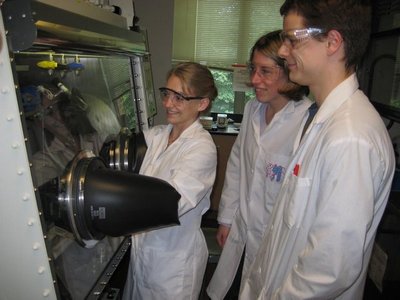August 2, 2007
Chemistry center wins $3 million NSF grant
A UW-based chemistry research center, poised to become a leader in science that will lead to new products and processes, has been awarded $3 million a year for five years by the National Science Foundation.
The $15 million grant to the Center for Enabling New Technologies through Catalysis will continue to foster research to find easier and better ways of manipulating strong chemical bonds found in most materials. Eventually, consumers could benefit from a variety of less-expensive goods, ranging from pharmaceuticals to oil-based products, created in ways that use less energy and generate fewer unwanted byproducts.
The center brings together more than 50 researchers from 10 universities and a national laboratory, and makes extensive use of Internet video conferencing capability.
There also are six industrial affiliates, which is a key element for the center, said Karen Goldberg, a UW chemistry professor who leads the collaboration.
“The idea is that the companies will be able to take the methods that we develop in our research and turn them into actual industrial processes,” she said.
The center was established under a different name in 2004 with a three-year, $1.5 million grant from the science foundation. It was one of three small chemical bonding centers established at that time, but it is the only one that received major second-phase funding of $15 million over five years.
Another major aspect of the center is its inclusion of graduate students in laboratory research and collaboration with other institutions, said Jim Mayer, a UW chemistry professor.
“Each of the students has a Web camera and a collaborator at another university,” Mayer said. “It’s wonderful for them to have the feeling that they actually are part of a bigger collaboration and can communicate with people at other institutions. We put the students front and center in this process.”
Mayer, Goldberg and Michael Heinekey, also a UW chemistry professor, are among the 16 scientists leading the center. At least two of the 16 must work together on any of the center’s projects, and some current projects involve as many as five of them. Using online capabilities to link a number of institutions provides the flexibility to move research projects and even add researchers as the need for different expertise arises, Goldberg said.
“Virtual centers, in which investigators are spread out geographically, represent a new direction for the National Science Foundation. Our center is developing new ways to exploit the cyber infrastructure to make the virtual center approach successful,” she said.
The center will engage in projects that are risky in terms of their chances of success but that also have the potential to make a major impact on society, Goldberg said. They include finding new ways to make chemicals, new ways to use existing fuels and even new and more energy efficient ways to produce fuels such as diesel and biodiesel. Already the center has made major strides in a process to turn coal, shale or vegetative matter into diesel fuel.
The center will be eligible for a five-year renewal when the latest funding ends in 2012.
Center Participants
University of Washington
University of California, Santa Barbara
University of Wisconsin, Madison
University of Illinois
University of Michigan
Rutgers University
University of Rochester
Massachusetts Institute of Technology
University of North Carolina
North Texas State University
Los Alamos National Laboratory
Industry Affiliates
The Dow Chemical Co.
Exxon-Mobil Corp.
Promerus LLC
E.I. du Pont de Nemours & Co.
Eastman Chemical Co.
Boehringer Ingelheim GmbH

